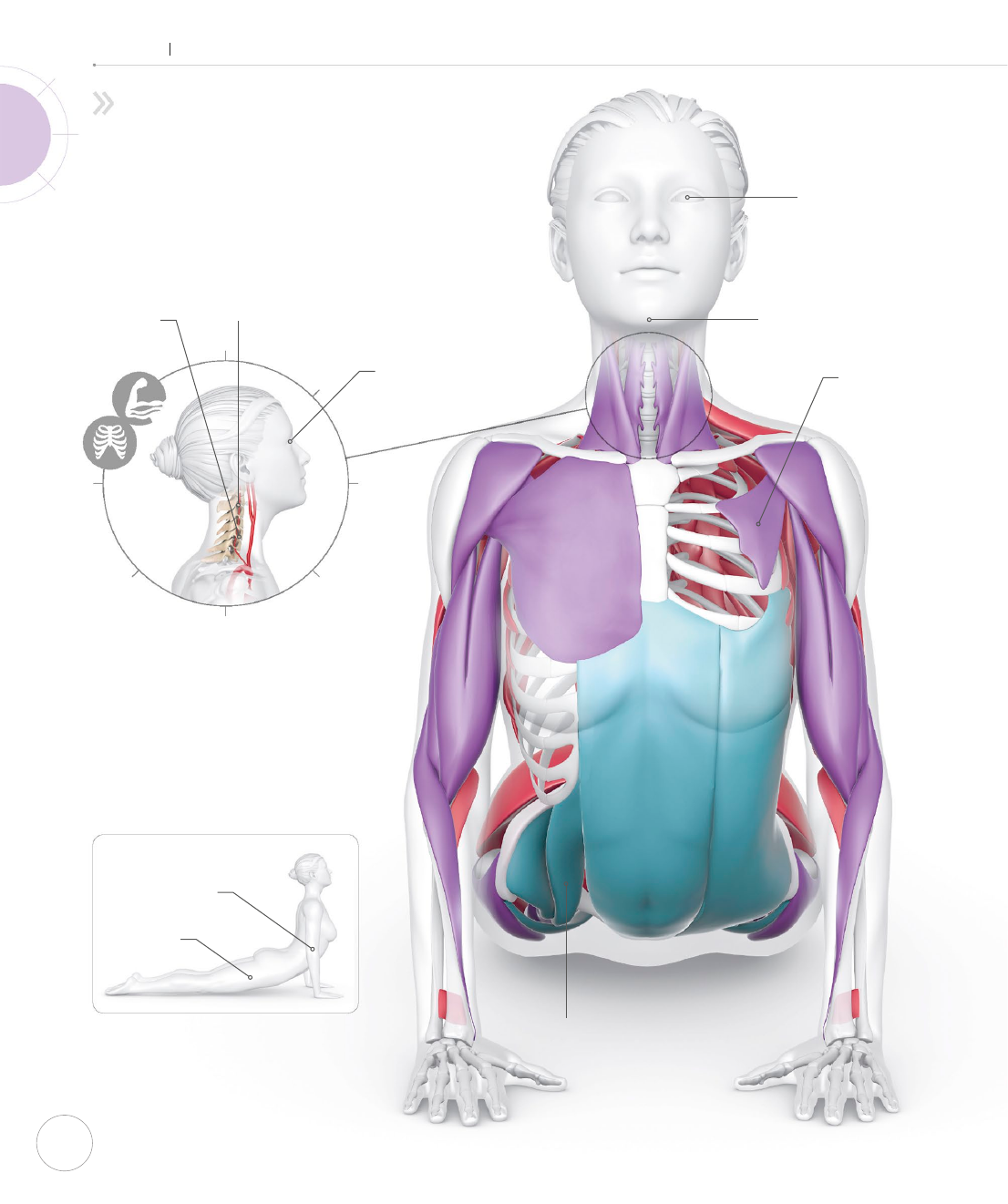
158
THE ASANAS
Floor
Cobra pose is a key traditional yoga pose. This gentle
backbend was believed to ignite a burning digestive
re and awaken the ow of dormant energy. It does
seem to stimulate digestion and elimination, while
helping to ease back pain for many.
THE BIG PICTURE
The front of your body—including your chest, abdominals,
and hips—is stretching. Meanwhile, muscles in your back,
shoulders, and arms are strengthening as you maintain the
posture, creating an even curve along your neck and spine.
COBRA
Bhujangasana
ALIGNMENT
Your pubic bone remains on the mat as you
elongate your spine into an even backbend.
If you feel pinching or pain in your lower
back, come down lower.
Shoulder blades down
and toward center
Even curve in spine
No pinching in
lower back
Buttocks not
clenched
Elbows bent
Even curve
in neck
Breastbone
reaches forward
and up
Pubis remains
on mat
Thighs
Your gluteus maximus, adductor
magnus, and hamstrings engage
to hold your hips in extension, while
your tensor fasciae latae and
iliotibial band stabilize your hips.
VARIATION
With your forearms on the floor,
Sphinx can be a more accessible and
more passive version of the pose.
Elbows under
shoulders
Neck long
and chin lifted
Hip
Gluteus maximus
Tensor fasciae latae
Biceps femoris
Semitendinosus
Vastus lateralis
Iliotibial band
Gaze straight
ahead
Toes
untucked
US_158-159_Cobra_01.indd 158 20/09/2018 21:16

159
Upper arms
Your triceps engage to resist
gravity, pressing into the
ground as if you are moving
toward elbow extension,
while maintaining some
elbow exion. Your biceps
also engage to stabilize.
Lower arms
Your pronators engage to
pronate your forearms,
pressing your thumbs more
rmly into the mat.
Torso
Your spinal extensors engage
to extend your spine while your
abdominals stretch. Your pectoralis
major stretches as you broaden your
chest while adducting your shoulders.
Your middle and lower trapezius
engage with your rhomboids to
retract and depress your scapulae.
Neck
Your cervical extensors engage to
extend your neck, and the cervical
exors engage while lengthening to
stabilize. This prevents your head from
dropping back and creates an even
curve through the length of your spine.
Rhomboids
Pectoralis major
Deltoids
Trapezius
Infraspinatus
Teres major
Serratus anterior
Triceps brachii
Brachialis
Biceps brachii
Elbow
Wrist
Pronator quadratus
Brachioradialis
Sternocleidomastoid
Splenius muscles
Upper trapezius
Longus muscles
Transversospinalis
Erector Spinae
Spine
Quadratus lumborum
Iliopsoas
Rectus abdominis
Internal obliques
KEY
Joints
Muscles
Engaging
Engaging while
stretching
Stretching
US_158-159_Cobra_01.indd 159 28/09/2018 17:10

160
COBRA
Bhujangasana
CLOSER LOOK
Cobra pose can be refined with activation of key
muscles like the serratus anterior. It can be adapted
to gentler versions such as Sphinx pose, or a deeper
backbend such as Upward-facing Dog.
Elbows are
straight but
not locked
Iliopsoas stretches
Thighs are
lifted
VARIATION
Upward-facing Dog is a similar pose
to Cobra, used more in some styles of
yoga. The thighs are lifted o the floor
with the elbows straight to create a
deeper backbend.
Neck problems
Traditional teachers have taught to throw the
head back as far as possible. However, we
now understand this has more risks than
benets. Based on case studies and anatomy
knowledge, you can choose to respectfully
adapt for safety and optimal function by
avoiding hyperextension.
Eyes gaze up
diagonally to
where the ceiling
meets the wall
Pectoralis minor
mainly stretches
Chin lifts
slightly
Blood vessels close
to spine can be
damaged in
hyperextension
Hyperextension
could increase
fluid pressure
in eyes
Keep spine
gently curved to
protect disks
ANTERIOR VIEW
US_160-161_Cobra_02.indd 160 20/09/2018 21:16

161
THE ASANAS
Floor
Rotator cu
muscles engage,
including your
infraspinatus
Calf muscles
are passive
and relaxed
Toes and feet
are pointed (in
plantar flexion)
Serratus
anterior
Gently
counteracts
mid-back
rounding
Upper back strength
By strengthening your upper
and middle back and stretching
your torso, you counteract
hyperkyphosis (see p.14). The
more passive forearm version
(Sphinx pose) can also be a
great option for hyperkyphosis
of the thoracic spine,
preventing dysfunction or
a “dowager’s hump.”
Serratus anterior
activation
Try gliding your hands back
without moving them on
your mat, pressing your
breastbone forward to
reduce pressure in your
spine. This also activates
your serratus anterior
muscles, which help with
functional movements like
reaching your arms forward.
Strengthening them could
relieve some neck and
shoulder pain.
Your rhomboids
engage to draw
your shoulder
blades toward
each other
Knees fully
extended
Hamstrings
lengthen but
engage to hold
hips in extension
POSTERIOR–LATERAL
VIEW
US_160-161_Cobra_02.indd 161 02/11/2018 14:05
..................Content has been hidden....................
You can't read the all page of ebook, please click here login for view all page.
